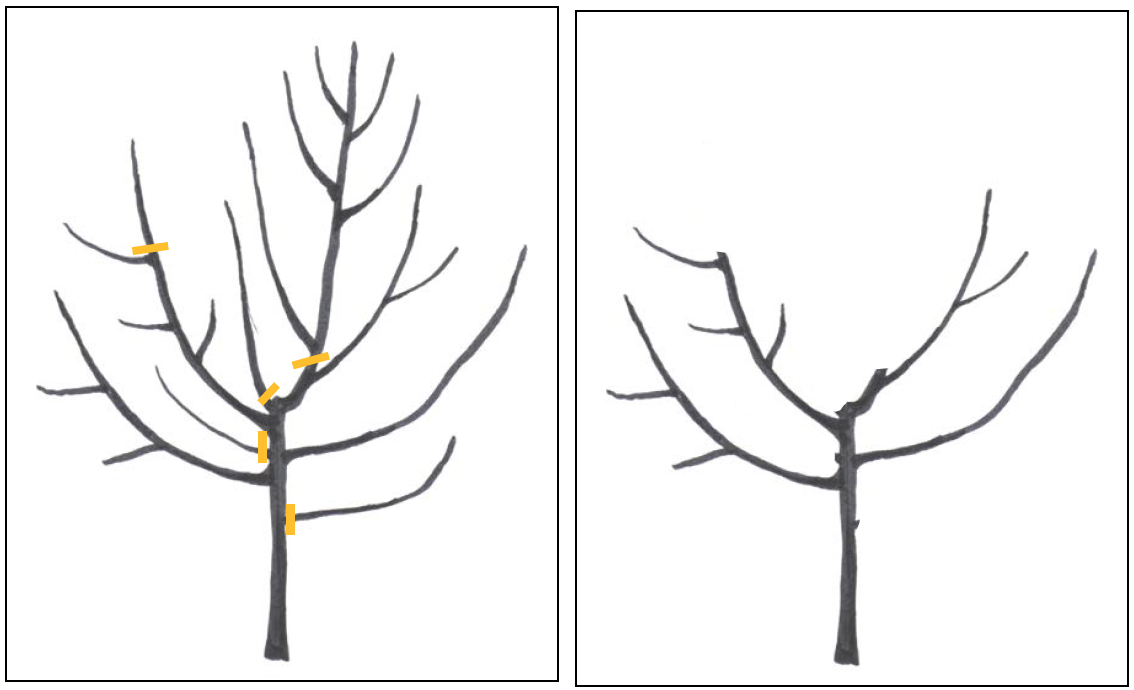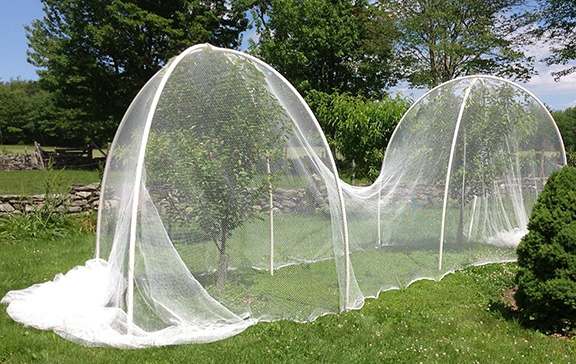Plums, cherries and apricots, which along with peaches and nec- tarines are often called “stone” fruits, are flavorful additions to the home orchard if the site is suitable. The first consideration is winter hardiness. European plums, hybrid plums, and sour cherries are quite hardy with some varieties tolerating winter temperatures of -20°F or lower. In more protected sites in the Northern part of the state, these stone fruits offer the best chance of success. Japanese plums, apricots and sweet cherries are less hardy and are best suited to home orchards in extreme southern New Hampshire.
A second consideration is the risk of spring frost injury to blossoms. These fruits, especially apricots, bloom in very early spring, often a week or more before apple trees bloom. They should be planted on sites that offer freedom from late spring frosts. Generally, these sites are elevated relative to the surrounding landscape which allows cold air to flow away on clear, cold nights.
Purchasing Trees
Purchase trees from a reputable garden dealer or nursery. There are several mail order nurseries as well that offer quality, bare-root trees. Select varieties that are hardy. Most catalogs offer approximate hardiness ratings. Specific variety recommendations are found below.
What about Dwarf Trees?
All fruit trees are grafted. A piece of vegetative wood (usually a bud for the stone fruits) is grafted onto a rootstock (a tree grown for just that use). Most of these rootstocks will produce a tree that is quite large; in the case of sweet cherries, these “standard-sized” trees often grow to 30 ft in height.
Dwarf rootstocks for plum, cherry, and apricot trees are not readily available for home garden use. Some nurseries now offer sweet cher- ries on dwarfing rootstocks from the Gisela series. These trees will be smaller and they will fruit earlier in life than full-sized or seeding trees. Since sweet cherry trees can be extremely large, making pest control and pruning difficult, purchasing sweet cherries grafted onto these dwarfing rootstocks is recommended.
Stone Fruit Varieties for NH
Methley, Shiro, Santa Rosa and Ozark Premier are Japanese plums that do well in southern NH. European plums to try include Early Italian, Green Gage, Castleton, and Stanley. In the northernmost regions of the state, the hybrid plums Underwood, Pipestone, and Superior are good choices.
Sour or pie cherries that have performed well in NH include Montmo- rency, North Star, and Meteor. The latter two are naturally dwarf and work especially well in home orchards.
On warmer sites in the southern part of the state, the sweet cherry vari- eties Black Gold, Sam, Lapins, and Hedelfingen are good choices, as are the apricot varieties Goldrich and Harogem.
Soil and Site
Fruit trees will do reasonably well in a wide range of soil types, although they will not tolerate poorly drained soils with a high water table. Stone fruit trees will do best on a site that offers full sunlight all day and should not be planted in the shade of buildings or large trees.
Proper soil preparation is an important first step. For best results, eradicate perennial weeds, such as quackgrass, before planting. The soil pH should be 6.0-7.0 for plums, cherries and apricots. Soil testing can be done through a number of private and public labs. UNH Cooperative Extension offers soil testing services.
Plant trees in early spring as soon as the soil is dry enough to work (late April through mid-May). If the planting site is not ready when trees ar- rive from the nursery, unwrap the trees and “heel-in” the roots in moist soil in a shady spot. Plant trees before their buds break. Plant plum, apricot, and cherry trees 15 to 20 feet apart in the home orchard.
Planting the Tree
- Dig a hole large enough to allow the roots to be spread out completely. This usually requires a hole that is wider than it is deep.
- Backfill the planting hole with topsoil. Do not use sod to fill the hole.
- If you purchase a “dwarf” tree, plant the tree with the graft union 2 to 3 inches above the soil surface. The graft union is the point where the variety was grafted onto the rootstock.
- Firm soil around the roots. Backfill the hole 2/3 full, soak in 2 gallons of water, and finish backfilling. If you leave a depression or water catching basin around the tree, be sure to fill it in by autumn to reduce the danger of ice damage to the lower trunk.
- Remove any tags or labels attached to the trees to prevent girdling of the trunks.
- Do not add fertilizer to the planting hole. Trees can be fertilized after rain has thoroughly settled the soil around the roots, about 3 weeks after planting. Apply 1/2 pound of 10-10-10 or its equivalent by spreading it lightly in a wide circle 16 to 20 inches from the tree trunk.
Pruning
Plum, apricot, and cherry trees are pruned and trained annually in early spring to develop and maintain tree size and shape. European plums, cherries, and apricots are generally trained to the leader system. In this system, a single trunk (or leader) is maintained. Lateral branches with wide crotch angles are developed. Trees are formed with wide bottoms and narrow tops to insure good light penetration into the tree canopy. Japanese plums are generally pruned in the open center system (similar to peaches), but will also do well pruned to the leader system.
Leader System Pruning
Pruning at Planting - Establishing the Leader

Heavily branched (or “feathered”) one-year-old nursery trees will rarely need pruning at planting except to eliminate oversized branches – branches with a diameter exceeding 1/2 to 1/3 the diameter of the trunk or leader. Remove any vigorous, upright branches that may compete with the leader or trunk for light.
Whenever a branch does need to be pruned, it is important to cut out the entire branch. If you prune offending branches by simply cutting a portion off the end, you will not solve the structural problem the branch is causing. Rather, the branch will re-grow in a vigorous and upright manner, creating unwanted shading of other wood and delayed fruiting. Remove the branch by cutting at the outside edge of the branch collar that forms where the branch is attached (Fig. 2).
While well-branched trees are the ideal, you often have to settle for trees that have only a few or perhaps no branches. If the few branches that exist are uniformly distributed around the tree, then no pruning is required.
If the tree is one-sided, the best course of action may be to remove all branches and start over. This is often the case when a tree comes with only one or two branches. After removing these branches, cut the leader off at a height of 33 - 36 inches above the ground to encourage development of wide-angled branches.

Leader System - Pruning in Later Years
The basic pruning rules do not change as the tree ages, although the size of some pruning cuts might. For leader-trained trees, continue to eliminate vigorous, upright branches that might compete with the leader and eliminate any oversized branches that develop.
Some branches that didn’t seem too vigorous in years 1 and 2 may become problems, growing at a much faster rate than other parts of the tree. These excessively large branches will need to be removed by cutting them out completely. Some shade problems may develop as growing branches crowd each other. Again, rather than cutting back all branches, selectively eliminate 1-2 whole branches to eliminate shading.
It is essential for the health of the tree that branches larger than 1/3 the diameter of the trunk where they are attached be removed over the first few years of a tree’s life.
Open Center System Pruning
Pruning at Planting - Establishing the Open Center System
If using the open center system for Japanese plums, head the trunk back to 24 to 30 inches at planting. Limbs arising below the heading-back cut should be cut in half to promote the development of strong, wide-angled scaffolds and thinned to leave only the best 3 or 4. Remove any limbs growing 15 inches or less from the ground.
Open Center System - Pruning Young, Non-Bearing Trees
In spring the year after planting, select 2 to 3 well-developed, wide-angled scaffold limbs and remove other branches entirely.
From the second to the fourth years, remove any branches that grow straight up through or toward the center of the tree. Prune lightly to eliminate overlapping and dam- aged limbs.
Open Center System - Pruning Bearing Trees
Maintain tree height at 9 to 10 feet by heading back scaffold branches to an outward growing lateral. Re- move weak or diseased branches as well as those that grow up, through or across the center of the tree or downward. Thin out remaining vigorous branches to prevent crowding.

Fertilizing
Manage stone fruit trees to ensure production of 6 to 12 inches of new growth each season. For most home orchards, an application of 1/2 pound of a complete garden fertilizer (such as 10-10-10) to non-bearing trees and 1 pound to mature bearing trees is sufficient. Adjust rates in response to tree vigor. If trees are growing too vigorously, do not fertilize. If trees are not growing well, double the fertilizer rate. Fertilizer should be applied in May by spreading it uniformly on the surface of the ground under the tree from the drip line in to within 16 inches from the trunk.
Pollination and Fruit Set
Sour cherries are generally self-fruitful and a single tree will do well. Most European plums and apricots are self-fruitful; however, cross pollination often results in larger, more dependable crops. For that reason, 2 or more varieties of each are generally recommended.
Sweet cherries and Japanese and hybrid plums generally require cross-pollination to set crops. Not all combinations work well and specific pollination needs of varieties are usually included in nursery catalog descriptions. The sweet cherry varieties Black Gold and Lapins are self-fruitful.

Thinning
Plums benefit from fruit thinning. Fruit size will be greater and disease risk reduced due to better drying of fruits after rains and heavy dew. Hand-thin plums in mid-June by reducing clusters of set fruit to single fruits.
Managing Pests and Diseases
Cherries are especially attractive to birds. It is not uncommon for the entire cherry crop to be destroyed by birds. Netting offers the best protection but application and removal can be difficult as trees grow. Flash tape, scare eye balloons and other visual deterrents offer limited control. More information about bird management is available in the publication Bird Damage Prevention for Northern New England Fruit Growers.

Stone fruits commonly experience several insect and disease pests in New Hampshire. These include brown rot and plum curculio on fruits and black knot on branches. Basic information on how to manage these pests is available in the publication Home Fruit Spray Schedule.
Download the resource for the complete fact sheet.
